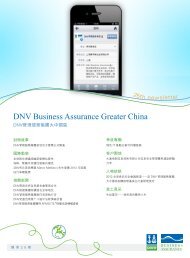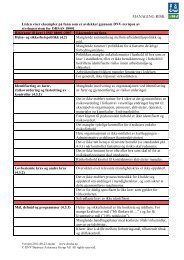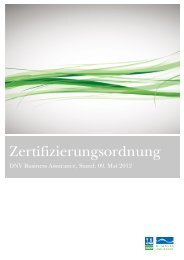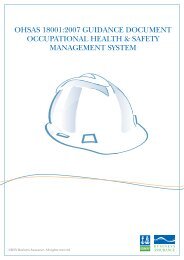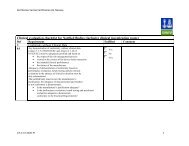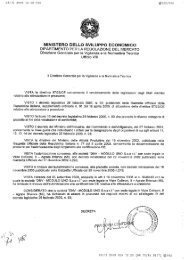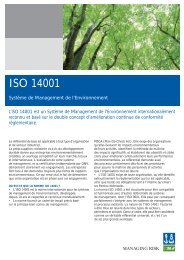Download - DNV Business Assurance
Download - DNV Business Assurance
Download - DNV Business Assurance
Create successful ePaper yourself
Turn your PDF publications into a flip-book with our unique Google optimized e-Paper software.
nical integrity, which is a prerequisite for<br />
a more optimal prioritisation of mitigating<br />
measures to ensure adequate safety and<br />
avoid severe production losses.<br />
“But TIMP is not really just a tool, it’s<br />
a concept. You can’t separate the portal<br />
from the change in culture, the difference<br />
in understanding and the knowledge<br />
and competence surrounding it,” says Mr<br />
Refsdal. “TIMP is a step change for managing<br />
the technical integrity of oil and gas<br />
plants, and the TIMP concept and the way<br />
it has been implemented across all Statoil’s<br />
assets has become a reference project in<br />
the oil and gas industry,” says Erik Østby,<br />
<strong>DNV</strong>’s Customer Service Manager for<br />
Statoil. A common risk-based method for<br />
measuring and visualising the actual technical<br />
condition of components and systems<br />
allows better decisions and the allocation<br />
of resources for repairs and modifications<br />
across the various operations.<br />
One important aspect of TIMP is the<br />
training of staff in understanding risk and<br />
the more efficient use of SAP, in which<br />
<strong>DNV</strong> has worked alongside the TIMP<br />
teams. In the course of seven months,<br />
approximately 1,600 employees have been<br />
trained in safety barrier management as<br />
a key element of controlling major accidental<br />
risk. A key success factor of the<br />
TIMP project is the interplay between the<br />
methodology developed for measuring the<br />
technical condition, the tailored work processes,<br />
the dedicated training of personnel<br />
and the IT tool supporting the entire process.<br />
If one of the four elements had been<br />
left out, the quality and thus the value of<br />
TIMP would have dropped significantly.<br />
DETAILS AND OVERVIEW<br />
In the TIMP Portal, users can go down<br />
to detailed levels and obtain information<br />
on every tag concerning the condition of<br />
each piece of equipment in a production<br />
facility.<br />
The TIMP Portal brings together information,<br />
facilitates reporting and creates a<br />
common rating system for the technical<br />
condition where there were previously<br />
many different rating systems and scales.<br />
“People have to see why it’s useful for<br />
them to be part of it,” Mr Refsdal says.<br />
“People always ask, ‘What’s in it for me?’<br />
The people who are using the portal can<br />
see that it gives them more structure. They<br />
know what their responsibilities are. They<br />
have the complete overview in one place.<br />
They see the value of it.”<br />
The result of the hard work behind the<br />
program has been good planning, a tight<br />
roll-out and dedicated employees across<br />
the board.<br />
As the program has become known in<br />
the industry, Mr Refsdal has been invited<br />
to give presentations about it at conferences<br />
and seminars.<br />
INTERNATIONAL INTEREST<br />
“There’s been a lot of interest in the project,<br />
especially internationally,” he says.<br />
“And it’s always important to ask what we<br />
can learn from others. The whole concept<br />
centres on learning.” The TIMP project<br />
team visited other companies and even<br />
other industries, such as aviation and<br />
high-speed rail companies, when gathering<br />
their initial input on how to create the<br />
system. Part of Mr Refsdal’s motivation<br />
in giving talks to the industry is to obtain<br />
feedback and improve the program even<br />
more.<br />
CONTINUOUS IMPROVEMENT<br />
The program was implemented in 43 facilities<br />
over the course of just seven months.<br />
Mr Refsdal says this rapid implementation<br />
was important in order to support a true<br />
shift in the way people work, not just incremental<br />
change.<br />
“When you make a system, sometimes it<br />
just stops there. But that’s when the real<br />
job starts. You have to change behaviour.<br />
People have to experience what’s in it for<br />
them, or else they will go back to their old<br />
behaviours. It’s an ongoing process,” he<br />
says.<br />
The future of TIMP might see even more<br />
expansion. There are plans to use it for<br />
subsea operations, for pipeline integrity<br />
and load-bearing structures; and perhaps<br />
also for drilling.<br />
Technical Integrity Management Program – TIMP<br />
Four main elements:<br />
<br />
A competence program based on training initiatives<br />
<br />
Work processes with clear roles, responsibilities and follow-up methods<br />
<br />
Technical integrity assessment of equipment and systems based on defined criteria<br />
<br />
The TIMP portal, which visualises technical integrity and assists in work processes<br />
TIMP has completed 100 training sessions with 1,600 Statoil engineers and managers. It has been developed in cooperation with many<br />
different groups of expertise in Statoil as well as with <strong>DNV</strong>.<br />
no 01 2012 – 25




